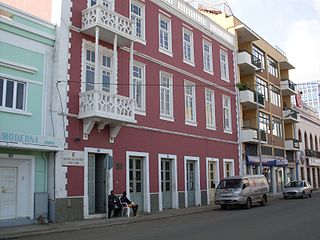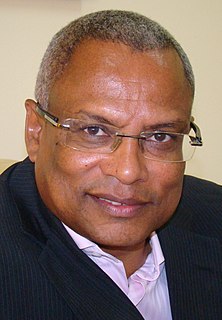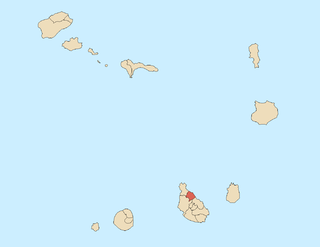Related Research Articles

Praia is the capital and largest city of Cape Verde. Located on the southern coast of Santiago island, within the Sotavento Islands group, the city is the seat of the Praia Municipality. Praia is the economic, political, and cultural center of Cape Verde.

José Maria Pereira Neves is a Cape Verdean politician who is currently the president of Cape Verde, having previously served as the Prime Minister of Cape Verde from 2001 to 2016. He is a member of the African Party for the Independence of Cape Verde (PAICV). In the 2021 presidential election, he was elected with 51.7% of votes, beating his nearest rival Carlos Veiga who got 42.4% of the total votes.

Eugénio de Paula Tavares was a Cape Verdean poet. He is known through his famous poems (mornas), mostly written in the Creole of Brava.

São Miguel is a concelho (municipality) of Cape Verde. It is situated in the northeastern part of the island of Santiago. Its seat is the city Calheta de São Miguel. Its population was 15,648 at the 2010 census, and its area is 77.4 km2. The municipality was created in 1996, when a parish of the older Municipality of Tarrafal was separated to become the Municipality of São Miguel.

Santa Catarina is a concelho (municipality) of Cape Verde. It is situated in the western part of the island of Santiago. Its seat is the city of Assomada. Its population was 45,920 in 2017 (estimate). Its area is 242.6 km2 (93.7 sq mi).
The Catholic Church in the Cape Verde is part of the worldwide Catholic Church, under the spiritual leadership of the Pope in Rome. There are over 430,000 Catholics in the country which represents over 90% of the total population. The country is divided into two dioceses: Mindelo and Santiago de Cabo Verde.

The Bank of Cape Verde is Cape Verde's central bank. Its headquarter is located on Avenida Amílcar Cabral, in the national capital of Praia on the island of Santiago. Its current governor is João António Pinto Coelho Serra, who is in office since December 2014.

The Roman Catholic Diocese of Bissau is a diocese located in the city of Bissau in Guinea-Bissau.
The Diocese of Santiago de Cabo Verde is a Latin Church ecclesiastical territory or diocese of the Catholic Church in Cape Verde. It covers the islands of Maio, Santiago, Fogo, and Brava. Its cathedra is within the Pró-catedral Nossa Senhora da Graça in Praia, Santiago. The diocese is immediately exempt to the Holy See and is not part of any ecclesiastical province.

Arlindo Gomes Furtado CSSp is the Cape Verdean Catholic bishop of the Diocese of Santiago de Cabo Verde, since 2009, and was the first bishop of the Diocese of Mindelo, from 2004 to 2009. In 2015, he was appointed as the first Cape Verdean cardinal by Pope Francis.

Cape Verde or Cabo Verde, officially the Republic of Cabo Verde, is an archipelago and island country in the central Atlantic Ocean, consisting of ten volcanic islands with a combined land area of about 4,033 square kilometres (1,557 sq mi). These islands lie between 600 and 850 kilometres west of Cap-Vert, the westernmost point of continental Africa. The Cape Verde islands form part of the Macaronesia ecoregion, along with the Azores, the Canary Islands, Madeira, and the Savage Isles.

Cape Verde was a colony of the Portuguese Empire from the initial settlement of the Cape Verde Islands in 1462 until the independence of Cape Verde in 1975.
The following lists events that happened during 1975 in Cape Verde.

Diogo Afonso was a Portuguese explorer.

João Crisóstomo de Amorim Pessoa was a Portuguese bishop. He was Bishop of Santiago de Cabo Verde and archbishop of Goa and Braga.

José Dias Correia de Carvalho was a Portuguese bishop, he was bishops of Santiago de Cabo Verde and Viseu.
The following is a timeline of the city of Praia, capital of Cape Verde.
The Culture of the Island of Santiago, Cape Verde is the richest in the nation, with a range of customs and practices common in the islands,
Francisco de Vasconcelos da Cunha was a Portuguese colonial administrator. He was born around 1590, and was governor of Portuguese Cape Verde from 1624 to 1628. He succeeded Manuel Afonso de Guerra, who was also the Bishop of Santiago de Cabo Verde. He was succeeded by João Pereira Corte-Real. In 1634, he became the captain-general of Portuguese Angola, succeeding Manuel Pereira Coutinho. He was succeeded on 18 October 1639 by Pedro César de Meneses.

The COVID-19 pandemic in Cape Verde is part of the worldwide pandemic of coronavirus disease 2019 caused by severe acute respiratory syndrome coronavirus 2. The virus was confirmed to have reached Cape Verde in March 2020.
References
- ↑ Carlene Recheado (September 2010). "As missões Franciscanas na Guiné (século XVII)" (PDF). Universidade Nova de Lisboa. p. 10.
- ↑ Henige, David P. (1970). Colonial Governors . pp. 236. ISBN 9780299054403.
- ↑ "Diocese of Santiago de Cabo Verde" . Retrieved 31 March 2013.